

As ARC Advisory Group learned in a recent briefing, Siemens has a broad offering tailored to the fiber 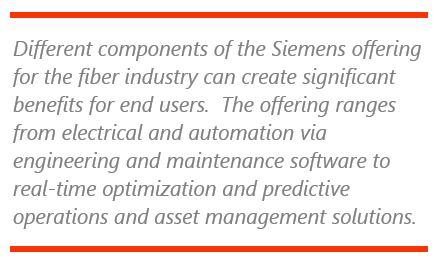
The global fiber industry produces pulp, paper, paper board, composites, and other fiber-based products for consumer, commercial, and industrial use. Currently, the global fiber industry is growing at 1 to 2 percent per year. However, developed countries in North America and elsewhere are experiencing significant decline, particularly for production of graphical papers for publications. In contrast, production of tissue paper is increasing due to increased demand for personal care products. Board production is also growing because of increased packaging requirements for on-line shopping. Plastic packaging, which is coming under scrutiny and pressure for a negative environmental foot-print, will stimulate further growth of paper board-based packaging products. This demand shift has led to conversion of machines from graphical to packaging grades.
The packaging materials industry has similar pressures as its clients’ product lifecycles become shorter and shorter, and there is an increasing need for mass customization, individualized production, and quality requirements. This implies smaller batches. To maintain profitability, companies must make faster and more efficient changeovers between grades or products.
Board production for packaging and building materials (such as for sustainable insultation applications) is becoming more challenging and requires higher performance. This sophistication brings more added value and requires a higher technical content and manufacturing complexity. These support industry resilience and competitiveness; but represent a challenge for the industry as it transforms itself.
The relative scarcity of paper for recycling has driven up prices for raw material. This increases pressure on profitability, leads to industry rationalization, and presents growth opportunities in regions with lower cost raw materials. Additional capacity coming online puts further pressure on prices and margins, especially for older plants. As capacity becomes increasingly specialized, the industry aims to improve operational efficiency. Capital expenditure is necessary to adjust to the changes in market supply and demand but must be well-controlled in the current competitive environment.
On top of economic challenges, the collision of two labor force trends create a real challenge for industry. First, due to the aging population, resources are exiting the labor force along with valuable knowledge and know-how. Second, digital transformation requires digital literacy and associated competencies; both scarce commodities these days.
Profitability can be improved by reducing cost and/or increasing added value. Cost reductions can come from operating or capital costs; added value can come from higher average sales prices or increased production. In almost any manufacturing industry, competitiveness can be increased by increasing technology content and complexity. As we learned, Siemens offers a number of options tailored to the fiber industry with the potential to increase profitability and competitiveness along a plant’s lifecycle.
This lifecycle phase includes the design, build, and commissioning of new plants or mills, but also modification and modernization of existing ones. In the conceptual design phase, the most impactful decisions are made regarding the plant’s capacity, efficiency, and flexibility in making different grades and the capability to provide targeted quality. Siemens’ COMOS engineering software is designed to enable the user to efficiently engineer process equipment, electrical, instrumentation, and automation using optimized, configurable workflows. Different disciplines can work in parallel on shared objects. Modular engineering templates enable standardization and reuse of designs. The software also facilitates engineering reviews with third parties and helps qualification and commissioning by comparing against requirements specifications.
To save energy in pulp and paper mills, Siemens custom-built steam and gas turbines can deliver high flexibility and lower cost, particularly when used in combined heat and power (CHP) generation. Siemens SIPAPER Power provides scalable integrated power supply and distribution and power management, including emergency power supply. The system is designed to provide intelligent automation, monitoring and management of loads, which can translate into up to 20 percent of energy savings.
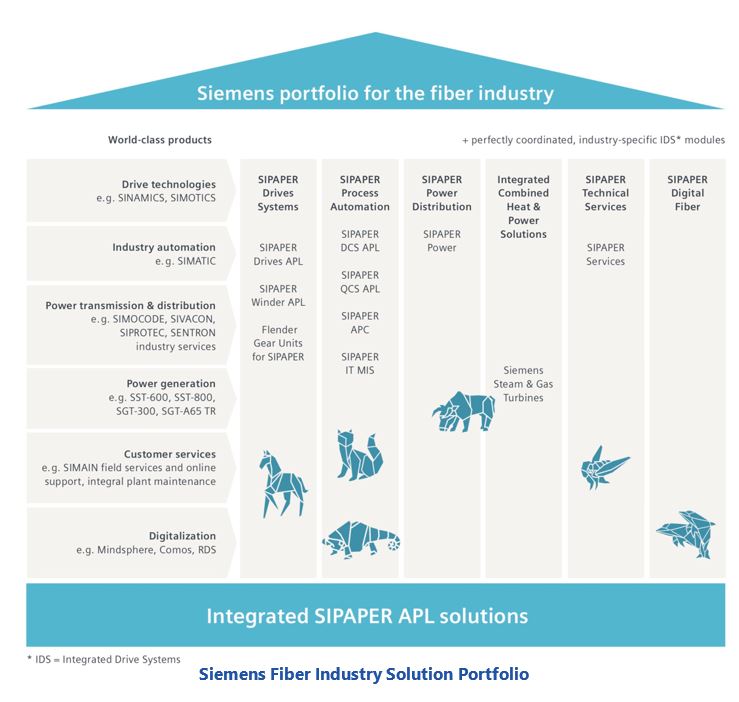
Siemens provides integrated drive systems comprised of compatible sets of motors, converters, couplings, and gearboxes covering all required performance, torque, and voltage ranges. Compatibility equates to 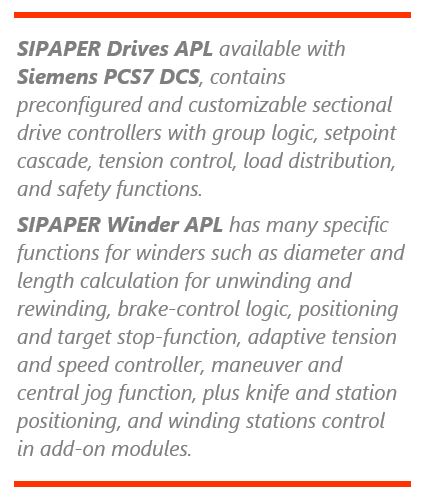
Advanced Process Libraries for the PCS7 V9 SIPAPER DCS distributed control system (DCS) are tailored to the fiber industry and contain modules that are ready to assemble and parametrize. This allows reuse of knowledge and helps free up time for optimization. According to Siemens, this all makes the control engineering, integration, and migration effort about one-third more efficient. A given design can be tested virtually both for hardware configuration and its programming with Siemens SIMIT prior to physical testing. This speeds commissioning and makes it quicker to resolve any issues.
Importantly, Siemens provides benchmarks and combines engineering with financial analysis and optimization. The organization has the capability to design solutions with high availability and reliability, for an optimum total value of ownership and return on investment. The service also includes assessment and digitalization workshops to help clients define their digital manufacturing strategies and plan their execution.
In addition to engineering, Siemens COMOS software can be used throughout the rest of the plant lifecycle. Asset information built up during the Design and Build phases is seamlessly transferred to operations and maintenance and can kept up-to-date using COMOS’ maintenance functionalities. NIST estimates that the cost of information losses during handover on paper to be 1.8 percent of capital expenditure. There is a huge opportunity to improve this process by making it electronic. However, there are more benefits to be reaped. When asset information is not kept up-to-date, maintenance efficiency and the quality of decisions go down, decreasing availability and reliability and increasing maintenance cost. NIST estimates the cost of information losses in the Operate and Maintain phases of the asset at up to 2.4 percent of the capital expenditure cost, a huge loss in competitiveness. For the many existing installations Siemens has developed many aids to transform difficult-to-access asset data into managed asset information. Workers in the field can also easily add information via their mobile devices. This can shorten the duration and reduce the costs of engineering projects because engineers spend much less time assessing the cur-rent plant status. Siemens has dubbed this synergy between design and detail engineering with plant engineering as “integrated engineering and operations.”
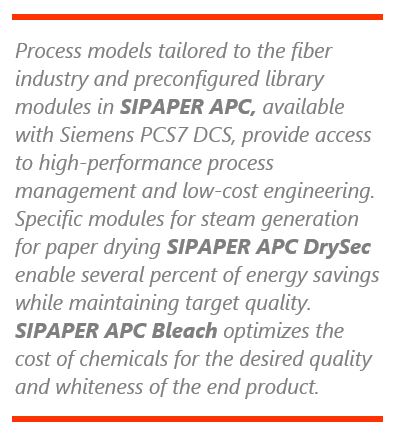
The Control Performance Analytics tool could help further improve performance by analyzing DCS control loops. The application will create reports that control engineers can use to plan appropriate remediation. While it will also recognize valve stiction, Siemens Valve Predictive Maintenance provides more detailed analysis of valve performance.
Once instrumentation and control loops issues have been identified and corrected, PCS7 DCS together with advanced process control (APC) provides continuous closed-loop operational optimization and brings the process smoothly and safely to optimal operating conditions.
Siemens has developed the SIPAPER Digital Fiber suite with many advanced features, such as performance analytics and condition monitoring systems, including energy monitoring and management.
SIPAPER Services provide online and technical support, spare parts, and repair. The organization also provides training and consulting for environmental or maintenance applications, modernization and optimization, and can provide turnkey solutions for condition monitoring and predictive maintenance. Companies can also outsource maintenance to Siemens.
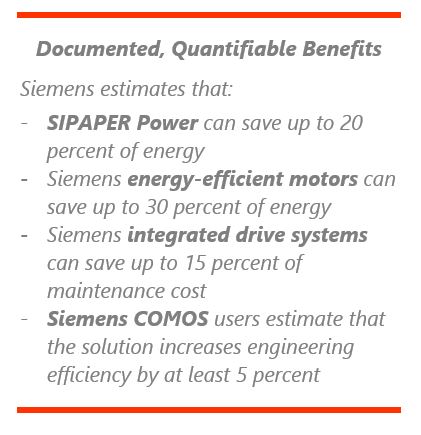 Potential Benefits
Potential BenefitsFor a mill with average performance, the solutions discussed in this report have the potential to increase fiber yield and reduce chemicals and energy consumption to a considerable degree. Integrated engineering can substantially reduce capital expenditure and shorten time to operational readiness. The solutions help capture, transmit, and reuse know-how and focus resources on activities with high added value. Good asset management practices with predictive maintenance solutions could improve asset availability, increase throughput, and extend asset life. Automated production, remote operation, and advanced control could further reduce costs to help squeeze several additional percentage points of profitability from an operating plant or mill.
ARC estimates that the cumulative potential benefits for a mill that applies the above-mentioned solutions can amount to reductions of 15 percent or more of recurring operational and capital expenditure. With finite resources, these cannot be captured at once. An operational and asset strategy is a key success factor in sequencing feasible projects with the desired financial and operational impact. Solutions with short pay-back periods can finance more ambitious follow-up projects. The project portfolio must also follow a feasible path of acceptance, learning, and acquiring know-how. This will enable companies to get most benefits out of Siemens’ broad palette of options to improve profitability and competitiveness.
ARC Advisory Group clients can view the complete report at ARC Client Portal
If you would like to buy this report or obtain information about how to become a client, please Contact Us
Keywords: Fiber, Paper, Board, Packaging, Competitiveness, Digitalization, Profitability, ARC Advisory Group.

